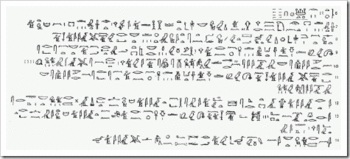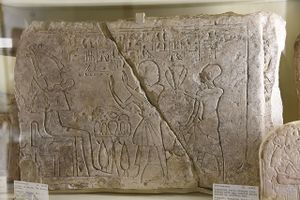سوپدو
| سوبدو | ||||
|---|---|---|---|---|
 سوپدو | ||||
| إله الحرب | ||||
| الاسم بالهيروغليفية |
| |||
| الرمز | صقر | |||
| الوالدان | سبدو | |||
سـوپـدو هو أحد الآلهة المصرية القديمة .
In Egyptian mythology, Sopdu (also rendered Septu or Sopedu) was originally the scorching heat of the summer sun. The effects of the scorching of the sun led many ancient cultures to see it as war-like, and the Egyptians were no different in this respect, with Sopdu consequently being seen as a war god.
في الأسطورة

صك ملكية قام به اوعاب، المسئول عن فيلق سپدو، رب المشارق، اوعاب: أنا أكتب ممتلكاتي لزوجتي، المرأة من گسعب، ابنة سات-سپدو شفتو، المسماة تتا، لكل ممتلكاتي التي حصلـْت عليها من شقيقي، الخادم المطيع للمشرف على الأعمال، عنخ-رن، as to each article in its place of everything that he gave me. She shall give it to any she desires of her children that she bears (has borne ?) me. I am giving to her the eastern slaves, 4 persons, that my brother, the devoted servant of the superintendent of works, Ankh-ren, gave to me. She shall give them to whomsoever she will of her children. As to my tomb, let me be buried in it with my wife, without allowing anyone to move (?) earth to it. Moreover, as to the apartments that my brother, the confidential servant of the superintendent of works, Ankh-ren, built for me, my wife dwelleth (shall dwell ?) therein, without allowing her to be put (forth) thence on the ground by any person. It is the deputy Gebu who shall act as guardian of my son (lit. “be child-educator for my son”).
اسم سوپدو، يعني مع سوپد، مشتق من تلك الحرارة التي تصل مباشرة بعد وصول النجم Sirius إلى صعوده الحلزوني، and thus being seen as coming with Sopdet, Sopdet being the deification of Sirius (Sopd is the masculine form of Sopdet, t being the feminine determinant). Indeed, it was said that Sopdet gave birth to this heat, and so Sopdu was seen as her child. The Greeks made a similar conclusion; the Greek name Sirius essentially means scorcher.
Because heliacal rising occurs in the east, and the sun's heat begins there daily, Sopdu was referred to as Lord of the East, and had his greatest cult centre at the easternmost nome of Lower Egypt, which was named Per-Sopdu, meaning place of Sopdu. The combination of being a war-god, and being associated with the easternmost edge, lead to Sopdu being depicted as an Asiatic warrior, with a shemset girdle and long axe, and more generally being said to guard Egypt's borders. When the Egyptians conquered Sinai, he was also thought to guard the turquoise mines, which predominantly lay within Sinai.
His name is composed of the hieroglyph for sharp, a pointed triangle, and the 3rd person plural suffix (a Quail); thus a literal translation of his name is sharp ones.[1] However, the triangle glyph was really a representation of a plant thorn, which the Egyptians referred to as a tooth, and so his name could be seen as the plural of tooth, i.e. teeth. Consequently, war-gods also being associated with death, he was said, in the Pyramid Texts, to protect the teeth of the deceased.
| ||||||||||||
| Har-Sopdu بالهيروغليفية |
|---|
بحلول المملكة الوسطى، كإله حرب، أصبح مقترناً بقوة مع الفرعون، الذي بالاضافة لكونه إله السماء، فإنه يؤدي إلى الاقتران بحورس، إله السماء، الذي قيل أنه راعي الفرعون. وبالتالي، فقد بدأ تصوير سوپدو معتمراً ريشتي صقر على رأسه، ليمثلا حورس، الذي كان يُصوَّر كصقر. He also started being identified as the standard bearer of Horus - gaining the glyph of a falcon on a standard in his name. By this time, the plural suffix of his name, previously a hieroglyph of a quail, was shown with the hieratic abbreviation - a swirl, which often leads to misinterpretations of the standard depicting the quail, which appears to have otherwise vanished. Eventually, the association with Horus lead to his identity gradually merging to Horus, and in the New Kingdom, he was referred to as Har-Septu, an aspect of Horus rather than an individual.
المصادر
- ^ Greek and Egyptian Mythologies By Yves Bonnefoy and Wendy Doniger, p. 221. University of Chicago Press, 1992 ISBN:0226064549
